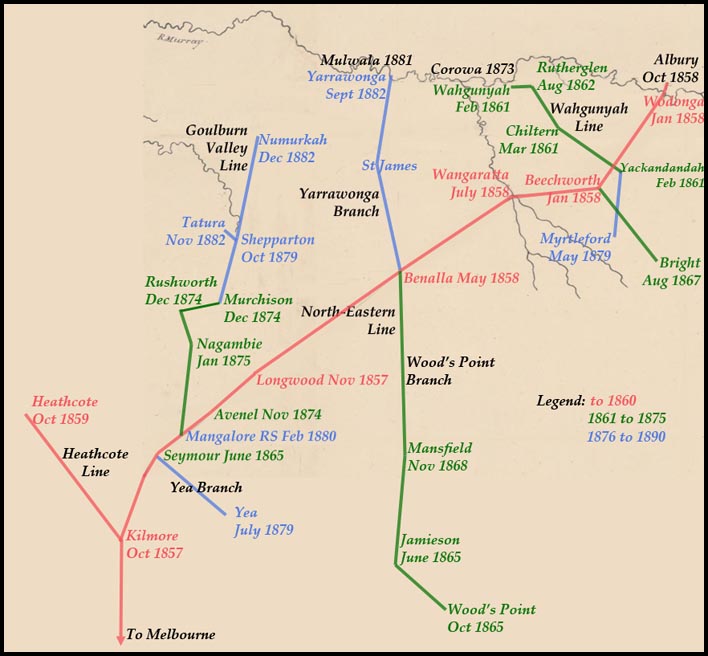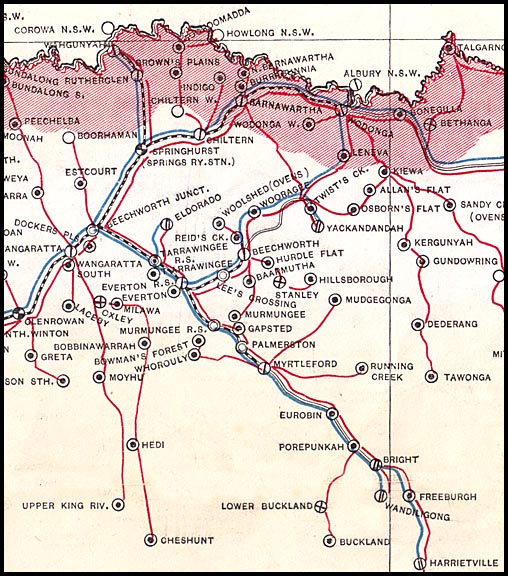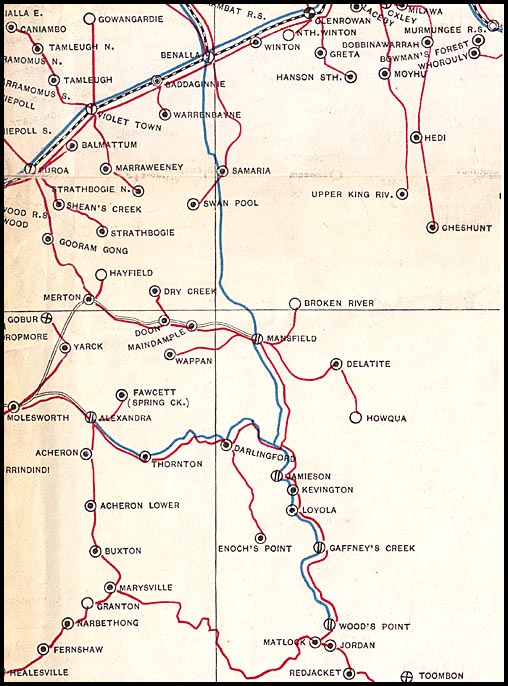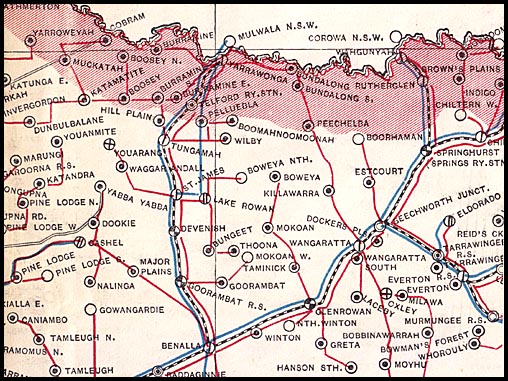The first line to New South Wales - the North-Eastern line.
- Home, index, site details
- Australia 1901-1988
- New South Wales
- Overview of NSW
- Telegraph lines
- Telegraph Offices
- Date stamps
- Forms
- Envelopes
- Rates
- Stamps
- Queensland
- Overview of Qld
- Telegraph lines
- Telegraph offices
- Date stamps
- Forms
- Envelopes
- Rates
- Stamps
- South Australia
- Overview of SA
- Telegraph lines
- Telegraph Offices
- Date stamps
- Forms
- Envelopes
- Rates
- Stamps
- Tasmania
- Overview of Tasmania
- General developments
- Reports
- Organisation
- Telegraph lines
- Telegraph Offices
- Date stamps
- Railway lines
- Forms
- Envelopes
- Rates
- Stamps
- Overview of Tasmania
- Victoria
- Overview of Vic.
- Telegraph lines
- Telegraph offices
- Date stamps
- Forms
- Envelopes
- Rates
- Stamps
- Ephemera
- Western Australia
- Overview of WA
- Telegraph lines
- Telegraph Offices
- Date stamps
- Forms
- Envelopes
- Rates
- Stamps
Once the feasibility of telegraphic communication had been demonstrated in Victoria, ambitious plans were developed by McGowan in conjunction with Charles Todd (in South Australia) and Captain B. H. Martindale (in New South Wales) to link the three Colonies as soon as possible. Hence the construction emphasis was to develop long lines to the borders immediately. There were various ways in which these inter-colonial connections could be made and indeed could be extended to international lines between the Colonies and England - see the visionary concepts embodied in one of the early proposals.
The Argus of 27 September 1856 reported that: "The survey of the North-Eastern line to connect Melbourne, Kilmore, Seymour, Benalla, Beechworth and Belvoir, is now in progress, and it is confidently anticipated that this extension (over 200 miles) will be placed in operation before the beginning of next winter. This line will constitute the Victorian section of telegraphic communication between Melbourne and Sydney, should the Government of New South Wales decide upon constructing the remaining portion of the line through that colony".
The line to the north-east of Melbourne was to meet the line originating at Sydney at Albury. The Victorian line terminated at Wodonga - which changed its name to Belvoir and then, on 26 July 1869, back to Wodonga. The first bridge between Albury and Wodonga opened in 1860 - well after the telegraphic link.
 |
Details are provided below for:
|
Main line from Melbourne to Wodonga.
Survey teams were required to map out the line from Melbourne to Albury. One of the members of the team was Mr. John Sharp who had lived in Albury for 70 years until his death in May 1926 at the age of 88. John had also been a member of the Burke and Wills expedition to Central Australia.
Construction began at both ends of the Victorian line in late 1857. It began with the Kilmore Telegraph Office opening in October 1857 and the line extending through Seymour to Longwood where a Telegraph Office opened in the following month. During the first half of 1858, the line was extended to Benalla and on to Wangaratta.
Telegraphic offices were opened progressively along the line. For example, intermediate offices were opened later at Seymour (1865) and at Avenel (1874).
Meanwhile, the line from Wodonga to the south-west began construction in January 1858 and the Telegraph Office at Wodonga was opened at that time. The line was immediately run to Beechworth in the same month and then on to Wangaratta soon after to meet the line from Melbourne.
Once the North-Eastern line had been completed in October 1858, a strategy was developed to open other offices along the line at later dates when funds became available and demand could be ascertained. The telegraph stations at Avenel (November 1874) and Reedy Creek (October 1882) are examples of these stations.
An extension of the main line was constructed in the mid-1880s south-east of Wodonga to Tallangatta (partly on the basis of gold and silver discoveries) and later extended. In 1894, an even more significant gold strike was made at Tallangatta.
In addition, six branch lines were constructed:
1. Corowa/Wahgunyah Line (No. 3 N.E.).
 |
The township of Wahgunyah was established in 1856 with a Post Office being opened in 1858.
It was an important location as it was the furthest upstream port on the Murray River. In addition, in 1864, George Sutherland Smith and John Banks from Scotland built the All-Saints winery at Wahgunyah and modelled the building on one of the Queen's castles - The Castle of Mey. Telegraphic communications were therefore vital and so a Telegraph Office was opened in Wahgunyah in February 1861. As Wahgunyah was opposite Corowa, an alternative telegraph line from Sydney to Melbourne was easily established in January 1873. As noted above, the first line to NSW had linked Wangaratta to Beechworth. The construction to include Wahgunyah therefore opened up the possibility of new routes in this busy area. Hence a line was extended north east of the Wangaratta-Beechworth line to Beechworth Junction and then on to Chiltern. The line from Wahgunyah was constructed simultaneously through Rutherglen to meet at Chiltern in March 1861. |
In the 1850s, Chiltern was on the Wahgunyah cattle run (it was then known as Black Dog Creek). By 1859, when the Post Office was opened, Chiltern was an important place on the main road between Sydney and Melbourne. The population had increased rapidly in 1858-59, due to gold being discovered in the region but, after becoming even more significant than Beechworth, the population declined in the 1900s.
A link was then made to Wodonga to join the main line and also to create an alternative in case of interruptions. The line originating in Wahgunyah was then extended to duplicate the original line through Beechworth to Wangaratta and on to Kilmore.
The main railway line branched from Springs (then Springhurst) to Wahgunyah in 1879 and included Railway Telegraph Offices at both places.
Yakandandah was also developing at that time with reef gold mining beginning in 1860. Hence the Wahgunyah line through Chiltern and Wodonga was extended as a short branch line from Beechworth to Yakandandah in 1861.
Another extension to the Corowa/Wahgunyah line was made in 1867. It was a separate branch to the south from a point about midway between Beechworth and Wangaratta - later to be named Everton. This line went south to Myrtleford and then to Bright in the general region where alluvial gold had been mined for some time. In addition to the need to service the gold fields, there was some element also of the line being a security measure. In 1857, the infamous Buckland Riot had taken place at Myrtleford when gold miners rose up against the Chinese prospectors killing many and causing 2,000 Chinese to flee. Order was restored by the police who were based at Beechworth but the possibility of further unrest motivated in part the decision to extend the telegraphic communications to that area. This extension was also continued to Harrietville to service the alluvial goldfields there.
The lines in this area were reclassified several times. By 1884, the Bright Branch incorporated the Telegraph Office at Wandiligong while the Beechworth Branch incorporated Myrtleford, Bright and Harrietville.
Soon after the opening of the Avenel Telegraph Office in 1874, a Branch line to the north was commenced and it was first documented under the name of the Rushworth Branch but by 1884, the name was changed to the Goulburn Valley line. It left the North-Eastern line just before Avenel at Mangalore and was constructed to Rushworth via Murchison by the end of 1874 with an intermediate Telegraph Office opening at Ngambie in January 1875.
In 1880, an office was opened at the new Mangalore Railway Station close to the main line where the connection had been made previously for the line through to Ngambie.
The general region to the north of Rushworth around Shepparton began development in the mid-1860s and was the subject of considerable land release. Hence, after a pause in construction following the opening of the line to Rushworth, the telegraph line was extended to Mooroopna and Shepparton from Murchison where the Telegraph Offices was opened about the end of 1879. Only a year before the Telegraph Office had opened in Shepparton, the first bridge was built over the Goulburn River. The first church was built in Shepparton at about the same time as the Telegraph Office opened (although no connection between these two events has ever been identified). In December 1881, tenders were called for the construction of the telegraph line east from Shepparton to Cashel (near the Yarrawonga branch).
By 1879, the nearby town of Tatura supported hotels, a butcher, baker, saddlers and other similar commercial buildings as well as 30 houses but no public buildings. So, in 1882, the telegraph line was extended from Shepparton through Tatura and also further to the north to Numurkah in conjunction with the expansion of the railway system in Victoria.
The Heathcote Branch was constructed in 1859. It was a simple extension from Kilmore - a distance of 56 miles of wire. It was constructed to service the very significant gold mining interests although most prospectors had gone by 1854. Those remaining were then concentrating on the deeper ore bodies. The line was later extended from Heathcote to Sandhurst (Bendigo) to provide an alternative route from Melbourne.
The Yea branch was constructed in 1879. It was a simple extension from Tallarook (below Seymour) - a distance of 23 miles of wire. By that time, the gold activity was very limited but farming and especially timber interests were becoming significant economically. Indeed the timber continued to develop into a major economic activity in the Yea district to about the 1920s.
5. Wood's Point Line - Wood's Point Branch:
 The blue lines represent telegraph lines in 1887. |
Construction of the Wood's Point line was commenced in late 1864. Its route was south from Benalla. Mansfield was added to the Wood's Point line in 1865 mainly because it was the centre of considerable farming and logging activity. In 1890, it was called Line 130 and it consisted of four stations - Mansfield, Jamieson, Gaffney's Creek and Wood's Point. Line 134 was a branch line linking Jamieson to Alexandra and Yea before terminating at Seymour. The Branch line between Jamieson and Alexandra was constructed in 1873. The Wood's Point line had to come south from the North Eastern Line because the Gippsland line was only being constructed in 1864 and there were no Telegraph Offices operational anywhere near where a Branch could leave.
|
The Age of 27 April 1865 reported:
Within a few weeks there will be direct telegraphic communication between Melbourne and Wood's Point, via Benalla. The contractor is vigorously pushing on the works. The line from Benalla to Wood's Point will be about eighty-five miles long; from Benalla to Jamieson, about sixty miles. The line is already in working order, and the remaining twenty-five miles will shortly be completed. The erection of this line of telegraph, in an alpine region, has been attended with considerable difficulty. The boon of instant communication between the metropolis and the rising mining townships of Gippsland will be fully appreciated, especially in the coming winter, when travelling by coach or horseback is a matter of much difficulty.
6. Wood's Point line - Yarrawonga Branch:
 The blue lines represent telegraph lines in 1887. |
A second line was constructed as part of the Wood's Point line but to the north from Benalla. Its main purpose was to establish another inter-colonial link with NSW through Yarrawonga and Mulwala (in NSW).
This branch - referred to as the Yarrawonga Branch line - was to the east of the Goulburn Valley (Rushworth) line. Construction on these two branch lines commenced. About 1880, Mulwala had over 100 people and a church, a school, a post-office and a public house. The Post Office had opened in 1864 but, after 6 weeks, was destroyed by a large fire. It re-opened on 1 June 1866. The Telegraph Office opened in 1881 linking Albury through Corowa, Mulwala to Deniliquin and Moama to the west. Hence the telegraph line was quickly constructed through St. James to Yarrawonga. |
A branch line to Lake Rowan was constructed from St James in 1875. It operated until 1890 when a telephone connection between the two Offices replaced the Morse connection. St. James was a town which was rapidly developing. |
|
Later St. James was the place where a shopkeeper named George W. Coles would sell his small shop to his oldest son George James Coles for £4,500 before moving to Wilmot, Tasmania to open another shop called "Coles Store". George Jnr. had been educated at Beechworth College. In 1914, George J. and his brothers opened another shop in Collingwood with the slogan "nothing over a shilling". From there, the major commercial empire began. Importantly - George would have sent many telegrams!!